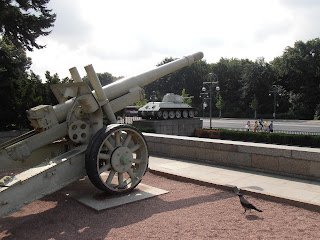Prussians and Austrians fought the allies (along with Russians and Swedes) and Napoleon had a contingents from the Confederation of the Rhine and Saxony in his army(together with French and Polish). About 5000 Saxons changed side part way through the battle. Post German unification this was considered a particularly poignant battle as Germans fought and died in large numbers on both sides.
Hitler used the monument as a symbol of German pride and there was a move to pull it down during the communist era. It survived as it was felt to be a good example of Russians and Germans fighting as comrades in arms.
We only had a chance for a short visit and work is being done on it for the 200th anniversary of the battle in 2013 but hopefully the pictures will give an idea of the scale.
Long view with artificial lake to the front
Closer view
Close up of the statues near the top of the monument











